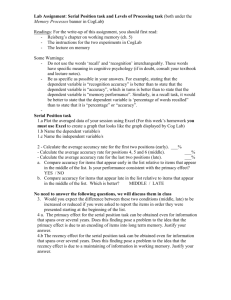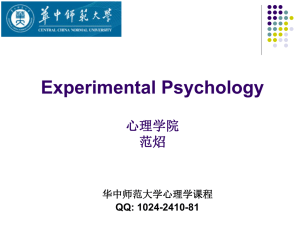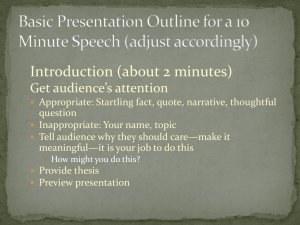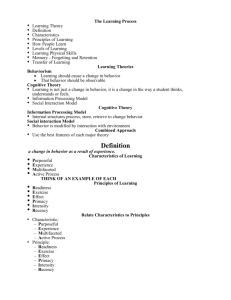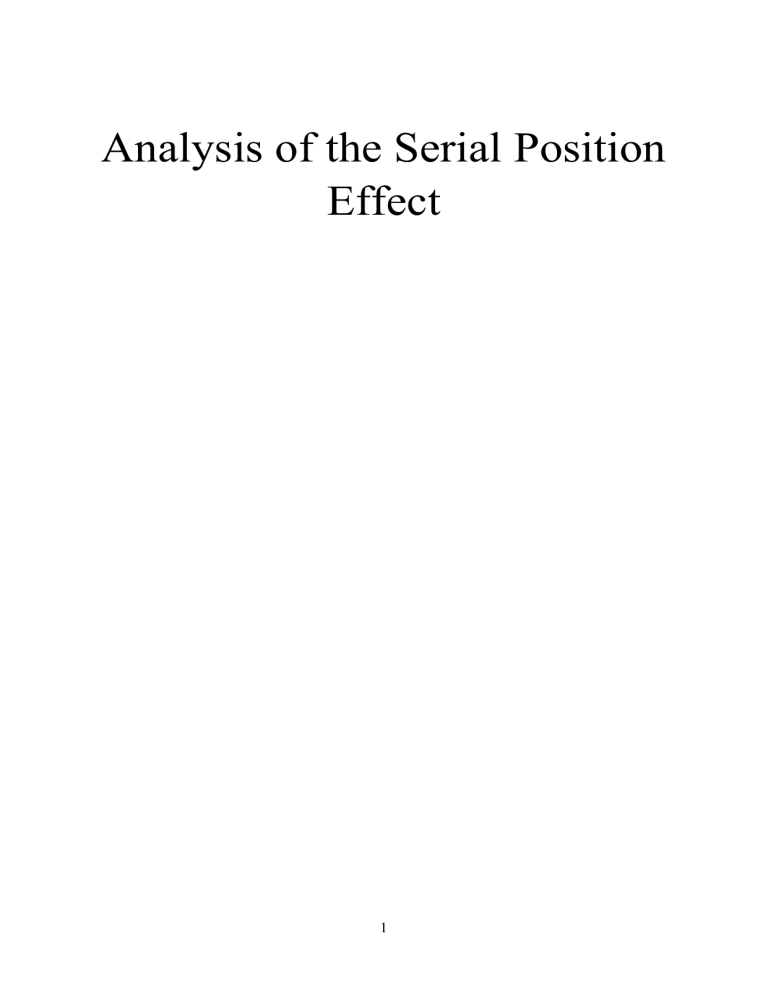
Analysis of the Serial Position Effect 1 1. Introduction The serial position effect is a psychological phenomenon discovered by Hermann Ebbinghaus in 1885. He utilized the well-known prompting or anticipation approach, in which the memorized list's contents must be recalled in the sequence they were memorized (Glanzer & Cunitz, 1996). The results of his research illustrate how the order of information in a series affects human memory. It implies that items appearing very early or very late in a series, will be remembered the best, whereas the middle ones are difficult to recall (Robinson & Brown, 1926; Deese & Kaufman, 1957). The probability of recall as a function of the word's position in a graph is generally U-shaped, with the initial peak being less than the end peak (Feigenbaum & Simon, 1962; Murdock; 1962; Glanzer & Cunitz, 1996 Tan & Ward, 2000) (see figure 1). The U-shaped serial position curve, according to this concept, is made up of two curves, each indicating output from a different storage system. The first is a long-term storage system, and the second is a short-term storage system (Glanzer, 1969; Glanzer & Cunitz, 1996). The assumption of a long-term and short-term storage mechanism implies that material recalled at the start of the list should be mostly output from long-term storage, and material recalled at the conclusion of the list should be primarily output from short-term storage (Glenberg et al., 1980). The first peak is also known as the primacy effect, whereas the second peak is known as the recency effect. This paper examines the serial position effect in terms of primacy and recency, as well as the economic consequences of both. Figure 1. Idealized serial position curve for 24-word list. Note: adapted from Murdock Jr, B. B. (1962). The serial position effect of free recall. Journal of experimental psychology, 64(5), 482. 2 2. Primacy Effect The primacy effect is a type of observer bias induced by people remembering the first events in a series the best. For a long time, researchers were baffled as to what created the primacy effect. Various explanations were proposed to explain the occurrence in the 1960s. Researchers acquired the same u-shape over and over again in single-trial free recall studies, but the primacy effect had so far eluded explanation (Tulving, 1968; Bruce & Papay, 1970). In the 70s, researchers discovered that the primacy effect is due to cumulative repetition of these things leading to improved transfer of knowledge about these items to long-term storage. After the first few things, the learner achieves a stable state of information overload, so new items in the middle of the list are processed roughly similarly, but with less processing than the initial ones (Rundus, 1971; Glenberg et al., 1980). The primacy effect has also been extensively researched in the field of economics, with linkages discovered in research on attitude development, purchase intention, and valuing an advertisement, brand, or company (Murphy, Hofacker & Mizerski, 2006). Asch (1948) was the first to conduct research on attitude development and presented two test groups with two individuals with identical characteristics. However, in the case of person A, the good traits were listed first, whereas in the case of person B, the negative traits were mentioned first. (A. intelligent—industrious—impulsive—critical—stubborn—envious. B. envious—stubborn— critical—impulsive—industrious—intelligent). His research found that A gives the appearance of a capable guy with flaws that do not overwhelm his strengths. B, on the other hand, is perceived by the majority as a "problem" whose talents are impeded by substantial challenges (Asch, 1948). Asch’s research on attitude development has been the basis for studies on economic impacts. Impression creation is critical for advertising seeking behavioral change (Haugtvedt & Wegener, 1994; Murphy, Hofacker & Mizerski, 2006). Attitudes toward the ads has also been linked with the primacy effect (Zhao, 1997; MacKenzie, Lutz, & Belch, 1986). Furthermore, Buda and Zhang (2000) discovered a primacy impact between information presentation and a product's attractiveness, desire to purchase, and perceived performance (Murphy, Hofacker & Mizerski, 2006). Finally, the desirability of options has an effect (Li & Epley, 2009). If the elements are unfavorable, they prefer initial choices; if the components in the option set are desired, participants choose later alternatives (Schosser, Trarbach & Vogt, 2013). This takes us to the topic of the recency effect. 3 3. Recency Effect The recency effect is a cognitive bias in which things, ideas, or arguments that were last are recalled more vividly than those that appeared first. This impact is said to be caused by recall from a limited-capacity, readily accessible yet labile short-term store. This hypothesis is reinforced by studies demonstrating that increasing the list length (Postman & Phillips, 1965) or the speed of presentation (Murdock, 1962) has no influence on the extent of the recency effect, as neither manipulation should change the capacity of short-term store (Glenberg et al. 1980). Nonetheless, the recency impact is negated when a full retention interval is placed between the end of the list and the recall attempt (Glanzer & Cunitz, 1966; Postman & Phillips, 1965). This purported manipulation requires the learner to empty short-term store of the final few list items in order to accept the new processing job filling the retention interval (Glenberg et al. 1980). The recency effect has also been extensively researched in the field of economics. Pathak, Garfinkel, Gopal, Venkatesan, and Yin (2010) discovered that more recently launched recommended items had a beneficial effect on merchants' cross-selling attempts on platforms such as Amazon. According to Buda and Zhang (2000), advertisers should give information from a nonexpert first and an expert last (recency effect) to have the highest probability of influencing brand purchasing favorably (Murphy, Hofacker & Mizerski, 2006). Lastly, people believe that the most recently sold stocks are the most salient, according to Nofsinger & Varma (2013). Their research reveals that the presence of another previously sold stock reduces a household's proclivity to repurchase another stock by 23%. The impact of prior profitability on repurchasing decisions is dominated by the recency effect. 4. Conclusion It is crucial to understand the serial position effect. The serial position effect refers to the finding that information delivered at the start (primacy effect) and finish (recency effect) is remembered better than information presented in the middle. In daily life, it is important to be aware of it because you can influence how people perceive you. In business, marketers can capitalize on the recency effect by ensuring that the beginning and finish of advertisements are pleasant and enticing. 4 References Asch, S. E. (1961). Forming impressions of personality (pp. 237-285). University of California Press. Bruce, D., & Papay, J. P. (1970). Primacy effect in single-trial free recall. Journal of Verbal Learning and Verbal Behavior, 9(5), 473-486. Buda, R., & Zhang, Y. (2000). Consumer product evaluation: the interactive effect of message framing, presentation order, and source credibility. Journal of Product & Brand Management. Deese, J., & Kaufman, R. A. (1957). Serial effects in recall of unorganized and sequentially organized verbal material. Journal of experimental psychology, 54(3), 180. Feigenbaum, E. A., & Simon, H. A. (1962). A theory of the serial position effect. British Journal of Psychology, 53(3), 307-320. Glanzer, M. (1969). Distance between related words in free recall: Trace of the STS. Journal of Verbal Learning and Verbal Behavior, 8(1), 105-111.’ Glanzer, M., & Cunitz, A. R. (1966). Two storage mechanisms in free recall. Journal of verbal learning and verbal behavior, 5(4), 351-360. Glenberg, A. M., Bradley, M. M., Stevenson, J. A., Kraus, T. A., Tkachuk, M. J., Gretz, A. L., & Turpin, B. M. (1980). A two-process account of long-term serial position effects. Journal of Experimental Psychology: Human Learning and Memory, 6(4), 355. Haugtvedt, C. P., & Wegener, D. T. (1994). Message order effects in persuasion: An attitude strength perspective. Journal of consumer research, 21(1), 205-218. Li, Y., & Epley, N. (2009). When the best appears to be saved for last: Serial position effects on choice. Journal of Behavioral Decision Making, 22, 378–389. 5 MacKenzie, S. B., Lutz, R. J., & Belch, G. E. (1986). The role of attitude toward the ad as a mediator of advertising effectiveness: A test of competing explanations. Journal of marketing research, 23(2), 130-143. Murdock Jr, B. B. (1962). The serial position effect of free recall. Journal of experimental psychology, 64(5), 482. Murphy, J., Hofacker, C., & Mizerski, R. (2006). Primacy and recency effects on clicking behavior. Journal of computer-mediated communication, 11(2), 522-535. Nofsinger, J. R., & Varma, A. (2013). Availability, recency, and sophistication in the repurchasing behavior of retail investors. Journal of Banking & Finance, 37(7), 25722585. Pathak, B., Garfinkel, R., Gopal, R. D., Venkatesan, R., & Yin, F. (2010). Empirical analysis of the impact of recommender systems on sales. Journal of Management Information Systems, 27(2), 159-188. Postman, L., & Phillips, L. W. (1965). Short-term temporal changes in free recall. Quarterly journal of experimental psychology, 17(2), 132-138. Robinson, E. S., & Brown, M. A. (1926). Effect of serial position upon memorization. The American Journal of Psychology, 37(4), 538-552. Rundus, D. (1971). Analysis of rehearsal processes in free recall. Journal of experimental psychology, 89(1), 63. Schosser, S., Trarbach, J. N., & Vogt, B. (2013). Is the First Option Worth Paying For?: An Experimental Study on the Primacy Effect. Technische Universität Kaiserslautern. 6 Tan, L., & Ward, G. (2000). A recency-based account of the primacy effect in free recall. Journal of Experimental Psychology: Learning, Memory, and Cognition, 26(6), 1589. Tulving, E. (1968). Theoretical issues in free recall. Zhao, X. (1997). Clutter and serial order redefined and retested. Journal of Advertising Research, 37, 57-74. 7
